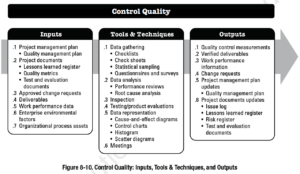
Project Quality Management is the 5th knowledge area within the Project Management Body of Knowledge (PMBOK). It contains the knowledge and processes required to ensure the highest quality products and deliverables are produced by the project. Although the highest quality should always be a goal, the highest grade is not necessarily so.
- Quality: The degree to which a set of inherent characteristics fulfill requirements.
- Grade: The performance specification to which a product is produced.
For example, a particular child’s toy might be high grade (many features, etc.), but if the parts break easily the quality could be unacceptable.
 There are three processes within this knowledge area:
There are three processes within this knowledge area:
- Plan Quality Management. The selection of the quality standards and production of the Quality Management Plan.
- Manage Quality Auditing the processes being used to achieve the quality standards.
- Control Quality. Measuring the quality of the deliverables.
Plan Quality Management
This process involves the determination of the quality standards that govern the project deliverables and/or product and how the project will achieve compliance to those standards. Many projects have standards that are given to them directly, such as design standards for buildings. However, many other standards often exist which are not explicitly stated but expected to be complied with. The project manager could purchase the applicable standards from organizations such as ASTM, IEEE, or ANSI to ensure a complete set.
The main output of this process is a quality management plan which dictates the quality standards and outlines how those standards will be met as well as the quality assurance and quality control activities.
PMBOK, 6th Edition, Section 8.1.3.1, “Quality Management Plan”
The quality management plan is a component of the project management plan that describes how the applicable policies, procedures, and guidelines will be implemented to achieve the quality objectives. It describes the activities and resources necessary for the project management team to achieve the quality objectives set for the project.
The quality management plan may be formal or informal, detailed, or broadly framed. The style and detail of the quality management plan are determined by the requirements of the project.
 Inputs
Inputs
- Project Charter
- Project management plan
- Requirements Management Plan
- Risk Management Plan
- Stakeholder Engagement Plan
- Scope baseline
- Project Documents
- Assumption log
- Requirements documentation
- Requirements traceability matrix
- Risk register
- Stakeholder register
- Enterprise environmental factors
- Organizational process assets
Tools & Techniques
- Expert judgment
- Data gathering
- Benchmarking
- Brainstorming
- Interviews
- Data analysis
- Cost-benefit analysis
- Cost of quality
- Decision making
- Multicriteria decision analysis
- Data representation
- Flowcharts
- Logical data model
- Matrix diagrams
- Mind mapping
- Test and inspection planning
- Meetings
Outputs
- Quality management plan
- Quality metrics
- Project management plan updates
- Risk management plan
- scope baseline
- Project documents updates
- Lessons learned register
- Requirements traceability matrix
- Risk register
- Stakeholder register
Manage Quality
Manage Quality is the process of auditing the quality requirements and the results from quality control measurements to ensure that appropriate quality standards and operational definitions are used. The quality audits test and/or confirm that the system is functioning correctly. Quality assurance should always be based on a foundation of continuous improvement.
 Inputs
Inputs
- Project management plan
- Quality management plan
- Project documents
- Lessons learned register
- Quality control measurements
- Quality metrics
- Risk report
- Organizational process assets
Tools & Techniques
- Data gathering
- Checklists
- Data analysis
- Alternatives analysis
- Document analysis
- Process analysis
- Root cause analysis
- Decision making
- Multicriteria decision analysis
- Data representation
- Affinity diagrams
- Cause-and-effect diagrams
- Flowcharts
- Histograms
- Matrix diagrams
- Scatter diagrams
- Audits
- Design for X
- Problem solving
- Quality improvement methods
Outputs
- Quality reports
- Test and evaluation documents
- Change requests
- Project management plan updates
- Quality management plan
- Scope baseline
- Schedule baseline
- Cost baseline
- Project documents updates
- Issue log
- Lessons learned register
- Risk register
Control Quality
Quality Control is the process of monitoring and recording results of executing the quality activities to assess performance and recommend necessary changes. In short, it is the measurement of defects.
 Inputs
Inputs
- Project management plan
- Quality management plan
- Project documents
- Lesson learned register
- Quality metrics
- Test and evaluation documents
- Approved change requests
- Deliverables
- Work performance data
- Enterprise environmental factors
- Organizational process assets
Tools & Techniques
- Data gathering
- Checklists
- Check sheets
- Statistical sampling
- Questionnaires and surveys
- Data analysis
- Performance reviews
- Root cause analysis
- Inspection
- Testing/product evaluations
- Data representation
- Cause-and-effect diagrams
- Control charts
- Histogram
- Scatter diagrams
- Meetings
Outputs
- Quality control measurements
- Verified deliverables
- Work performance information
- Change requests
- Project management plan updates
- Quality management plan
- Project documents updates
- Issue log
- Lessons learned register
- Risk register
- Test and evaluation documents
Tutorial Navigation
- Previous Page: Project Cost Management
- Next Page: Project Resource Management
- Tutorial Home: PMP Exam Tutorial




